Galleries
Why You Should Be Suspicious of the ‘Creative Economy’
There are many, many art students, but few artists.
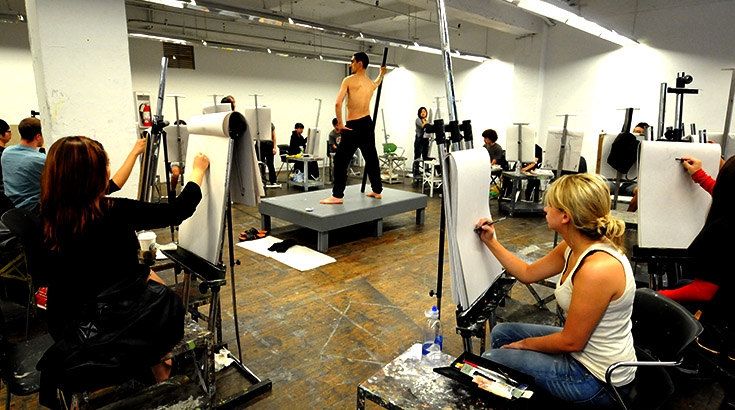
Photo: Courtesy SVA
There are many, many art students, but few artists.

Ben Davis

One-thousand six-hundred fifty-four.
I’m not teaching this semester, but if I were, that is the one number that I would want everyone to remember.
It is the reported number of “fine artists” sustained by the booming visual art industry in New York City (as of two years ago), according to Creative New York, a 2015 report on the health of Gotham’s “Creative Economy.”
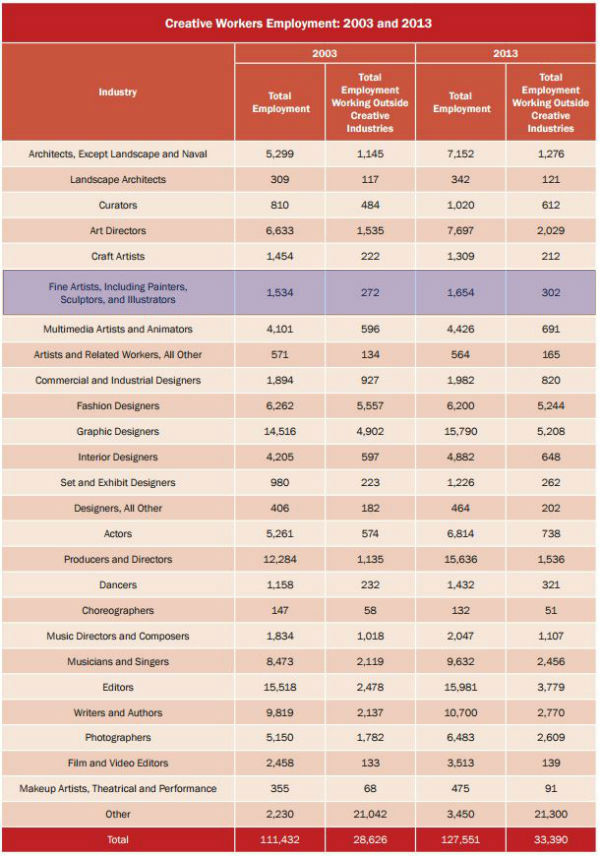
The top “Creative Economy” jobs in New York (with “Fine Artists” highlighted)
Image: Courtesy Center for an Urban Future
The School of Visual Arts enrolls about 400 in its “Fine Arts” section (graduate and undergraduate). Pratt Institute has 374. Parsons, the New School for Design, is training about 114 undergraduates and 46 grads. Cooper Union has about 280 students in its art programs, while NYU’s Steinhardt school enrolls about 220 art undergraduates, plus a few dozen more in its graduate programs.
That already takes us to more than 1,400 art students, and these are just the programs I can name off the top of my head. It follows that at any given moment in New York there are many, many more artists in the process of being added to the pool than there are successful artists who have “made it” in the entire city.
Creative New York tells us that back in 2003, the number of “Fine Artists, Including Painters, Sculptors, and Illustrators” was 1,534. Thus, in a decade, the thriving New York art industry made room for exactly 120 more artists in the city to support themselves via their art.
According to artnet Analytics, the US art auction market, of which New York is the indisputable hub, surged from $1.2 billion to $4.9 billion in the same 10-year period—effectively quadrupling. New York’s artist population experienced no corresponding surge. If anything, the same money that drove the art boom drove a luxury property boom that has made it more difficult to find affordable living space, let alone affordable studio space (something Creative New York argues specifically).
Statistics that count artists are notoriously slippery (the New York Times recently drew fire for its use of statistics to prove that the Internet was helping musicians). The total number of working artists squeaking by out there could be a few more or a few less, depending on whom you include. But even if you think that this is a massive undercount, you can’t like those odds.
And these are the good times. The central premise of Creative New York is that the city’s “Creative Economy” is thriving. Which brings me to the idea of the “Creative Economy” itself.
Because if I had another lesson to give to students, it would be this: When you hear this term, be very, very suspicious.
In general, the concept is an unhelpful portmanteau, squashing together those who work in corporate advertising and entertainment industries (which have their own industry-specific trade groups, incidentally) with independent “fine artists” of various kinds.
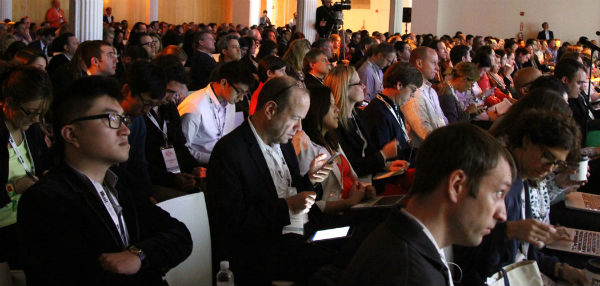
The 2014 Ad Age Digital Conference
Image: Courtesy Ad Age
As far as I can tell, beneath the surface, the justification for this tortured alliance is this: The concept of the “Creative Economy” is popular because it is a way to make an economic case for supporting fields, like fine arts, that aren’t able to support their practitioners economically.
The ad industry doesn’t really need the help. Creative New York is full of policy prescriptions to help the arts, from “Develop affordable housing for artists” to “Create an MBA-style boot camp for cultural nonprofit administrators.” But none of these seem to have much to do with Madison Avenue.
Meanwhile, the magical economic externalities attributed to art as reasons for supporting it—it helps “build community,” draws tourists, and so on—can only, by a spectacular stretch of the imagination, be applied to ads.
So why smoosh them together? The answer seems to be this: You need to include the more strictly corporate fields to make the case for the robust economic importance of “creativity.” Just two sub-fields in the Creative New York tally, “Motion Picture and Video Production” and “Advertising Agencies,” account for about one third of “Creative Economy” jobs all by themselves.
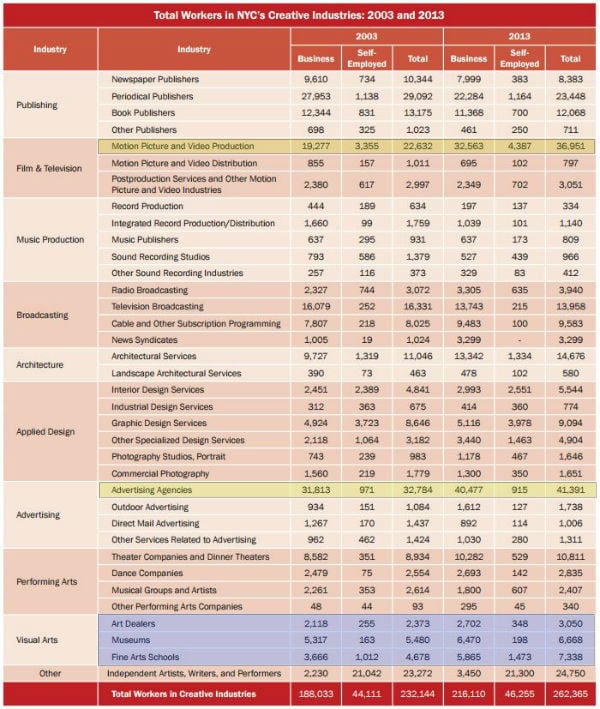
New York’s creative workers, by industry (with notable fields highlighted)
Image: Courtesy Center for an Urban Future
By comparison, visual art is tiny, even if you count all its attendant support industries. Between 2003 and 2013, the number of jobs added by New York’s “Motion Picture and Video Production” and “Advertising Agencies” categories (about 23,000) was more than the entire amount currently employed by all “Art Dealers,” “Museums,” and “Fine Art Schools” combined (about 17,000).
Interestingly, when I talked to Adam Forman, the helpful author of the study, his explanation was: “Advertising is the foundation of a successful creative economy.” He pointed to how Andy Warhol sustained himself as a commercial illustrator before hitting it big in Pop art, among other things.
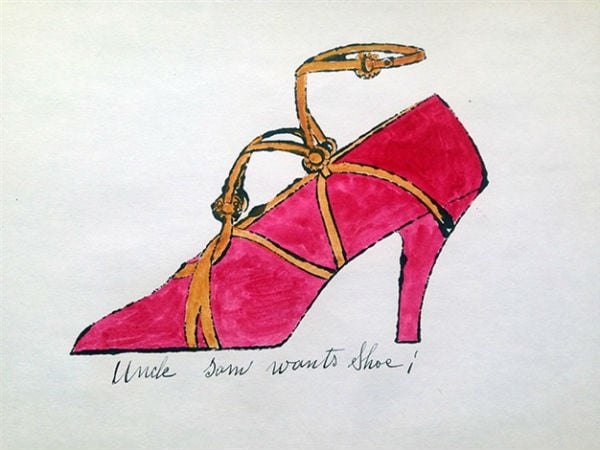
Andy Warhol, Uncle Sam Wants Shoe (1950)
Image: Courtesy Guy Hepner
Forman’s observation is really an example of how different the employment dynamics are within these distinct fields, but it does point to something important: Most “fine artists” make their rent through work totally outside their own practice, often in the far-flung branches of the broadly defined “Creative Economy.”
Still, I think that on the whole the notion of a “Creative Economy” is obfuscating when it comes to trying to figure out what is going on in the specific case of fine art. The much-lamented professionalization of the visual arts has not extended so far that most—or even many—artists make a profession out of it.
There’s a subway ad for SVA that tempts passersby to “Make Practical Use of Your Wildest Dreams.” This come-on is similar to ads that tout the Lottery by showing you how great it would be to win it.
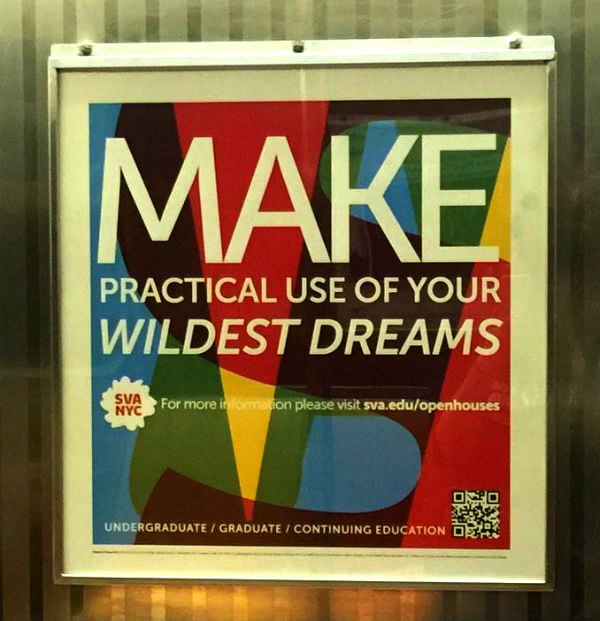
Ad for the School of Visual Arts
Photo: Ben Davis
Compare that pitch to this quote by New York artist Jennifer Dalton, from the book Living and Sustaining a Creative Life:
I remember the first time someone told me that many artists with apparently thriving careers and gallery representation still had day jobs. It was the first of a very long series of realizations that the art world is at least 50% smoke and mirrors. At the time I felt an almost personal betrayal at the realization that artists I had already perceived as incredibly, unattainably successful still had to find another way to pay the bills.
If you have the resources, art school has a lot to recommend it. It may make you happier; it may make you better at expressing yourself; it may give you a network of like-minded people to sustain you creatively; it may teach you how to formalize and present your own creative ideas so you can teach them to others.
These are all fine things.
But even of the luckiest of the lucky, only a very few—1,654 in NYC, according to the experts at Creative New York, and 3,660 in the country as a whole, according to the government—will get the whole package, making a living off of their work alone.
For the most part, becoming an artist is not something one does because there is a booming “Creative Economy” that supports that choice. Anyone who tells you otherwise is selling you something.